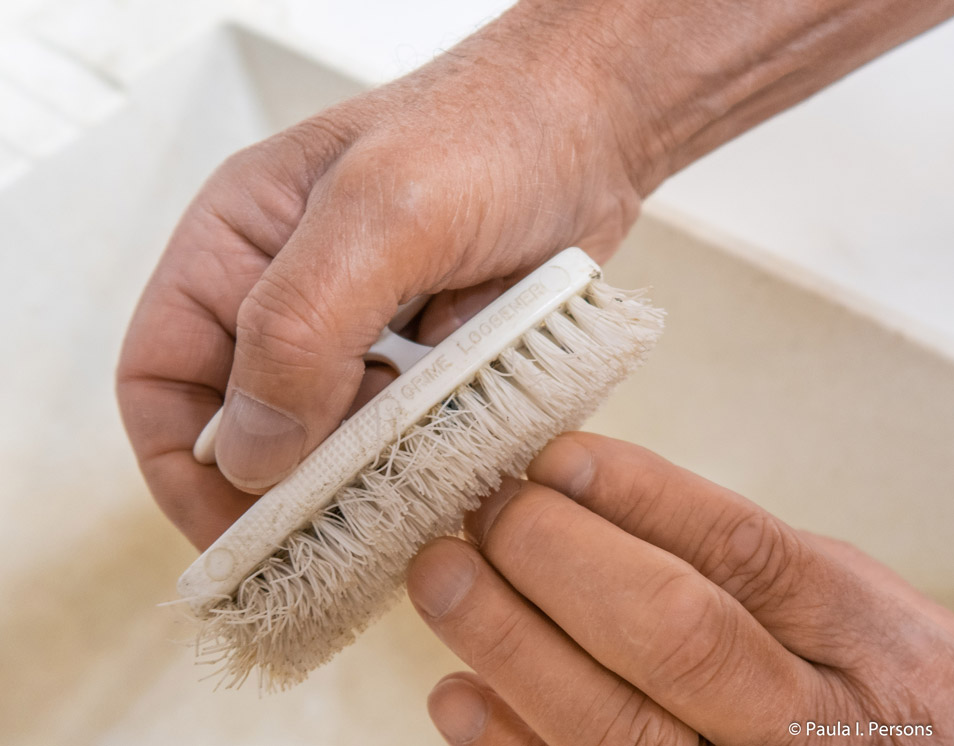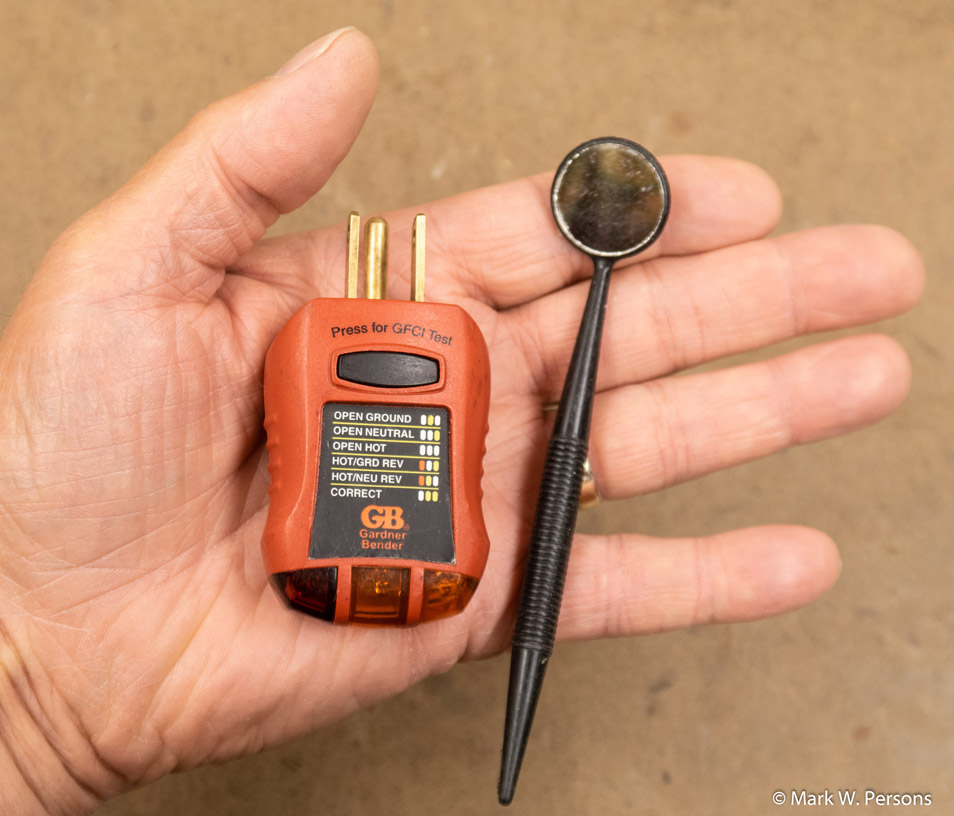
 |
|
|||||||||
|
|
 |
||||||||
 |
A Sampler of Common-Sense Helpers by Mark Persons |
Radio
World Article October 24, 2018 |
| With the holidays coming up, our intrepid author offers a cornucopia of useful suggestions |
|
When you work on a transmitter, especially a tube model, you’ll encounter very fine gray-black dirt particles. After my days working at transmitter sites, my wife Paula often said, “You smell like a little transmitter.” The first task was to wash my hands, but they often stayed black because of dirt embedded in the skin. Paula wouldn’t let me sit down to eat with dirty hands. |
 |
| Fig. 1: Use a nylon brush to remove dirt from under fingernails. |
|
Here’s another basic tip: Use a plastic stool for jobs that would otherwise require squatting. It can also be used as a step to reach up just beyond your normal height. A stool of this type costs less than $4. I carried one in my service van for the last 15 years on the job. It worked great. For kneeling, use a pad to prevent knee problems. You’ve seen them: inch-thick rubber or foam sheets that are about 8 by 15 inches. These are as inexpensive as $3. For continuous use on a project that requires more movement, use knee pads that strap to your legs. The construction trade uses them. You can too. |
 |
| Fig. 2: A plastic stool prevents sore knees. |
| An Xcelite 2210 tool gives a perfect crimp every time on solderless terminals of three sizes. I’ve found the reliability to be 99.99 percent during the course of 20 years of frequent use. With traditional crimpers, you can squeeze as hard or as little as you like. That’s a problem because the integrity is not always as good as you’d want. Best to pull on a terminal after crimping to make sure it is tight and will stay on the wire. The 2210 is a hand-operated machine, which won’t release until it has gone through a complete crimping cycle. They are a single action that crimps terminals in two places. Look for what is now called the Draper Expert 35574 Ratchet-Action Terminal Crimping Tool; I recently saw it for sale on Amazon for $33.54 plus shipping. Voilamart appears to have the same tool for as little as $12.99. |
 |
| Fig. 3: A professional-grade wire terminal crimper |
|
Using a shorted 120 VAC power cord as a test tool to locate a circuit breaker is a bad idea! For starters, the life of the circuit breaker will likely be shortened by such an act. If you do the math, a 100 foot long 15 ampere circuit will draw 237 peak surge amperes when shorted. A 50 foot 20 ampere circuit could hit 756 amperes of surge current and 90,720 watts on a circuit designed to deliver a maximum of 2400 watts. Ouch, that’s 38 times the rated current! It’s hard on the wiring as well. Sure, the circuit breaker will trip quickly, but wire nut splices and other power outlets along the way could suffer as well. |
 |
| Fig. 4: Use circuit breaker finding tools to trace wiring. |
|
INTERMITTENT
CONNECTORS |
 |
| Fig. 5: Use Caig DeoxIT on a BNC connector. |
|
SPEAKING OF CONNECTORS … I ran into a problem on a C-Band satellite dish years ago where only some of the transponders came through. On a whim, I replaced two right-angle N adapters at the low-noise amplifier with a short N-to-N jumper cable. Problem solved. Apparently, the spacing between the two 90-degree adapters was such that it formed a trap of sorts to notch out one or more transponder frequencies. Remember, we are talking 4 GHz. The satellite dish installer must have thought it was a clever idea to install this “U” connector arrangement to join a sky-pointing LNA connector to a half-inch coaxial cable. While we don’t see many LNAs anymore, the lesson is that bad/strange things can happen when transporting microwave RF frequencies. The potential for problems is much less at lower frequencies. MORE TOOLS Your tool kit should include a ground fault circuit interrupter tester, even if you are not an electrician. The GFCI shown in Fig. 6 is a hardware store item that typically sells for less than $10. This one has lights to identify five problems, in a circuit, plus a pushbutton to test GFCI-protected outlets. Best to use it whenever there is a question about 120 VAC wiring at a site. First, you’ll determine if power is available at an outlet, you might find the hot and neutral conductors are reversed or the ground is missing. Now we are talking dangerous. Check the power extension cords you carry. They could be wired incorrectly or have a broken connection. Use tools with three-wire power cables whenever they are not battery powered. A man in my area was electrocuted a few years ago while using an electric drill on a boat dock. The drill was metal-cased and someone had cheated the power cord plug by clipping the ground pin off. He was standing in water and would have been safe if the ground was present or if the power outlet was GFCI-protected. Remember, GFCI outlets are required under the National Electrical Code whenever there is water nearby. Transmitter sites are a good place for GFCI-protected outlets. Sure, it is dry inside, but you might be working outside at the base of a tower where the ground is wet. Be safe rather than sorry. |
 |
| Fig. 6: A power tester and mirror for your kit. |
|
A dental mirror is also shown in Fig. 6. It is great for looking around corners. Note that this tool is plastic cased to avoid the possibility of shorting a circuit to ground conducting power to your hand. Think safety! Use the right tools to save yourself time and trouble. It makes perfect sense. |
|
Find this article at Radio World: https://www.radioworld.com/tech-and-gear/a-sampler-of-common-sense-helpers Comment on this or any article. Write to radioworld@futurenet.com. |
| Mark Persons, WØMH, is an SBE Certified Professional Broadcast Engineer, recently retired after more than 40 years in business. His website is www.mwpersons.com. |
|
Questions? Email Mark Persons: teki@mwpersons.com |
|
.